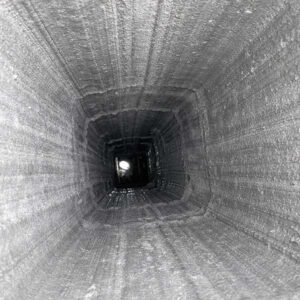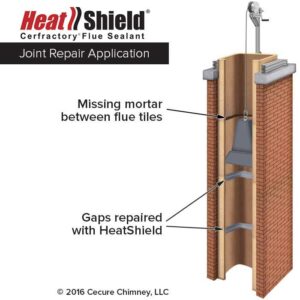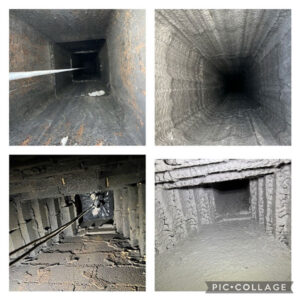Chimney Relining Professionals
Need Your Chimney Relined? Ask Us About HeatShield®
There are few things more comforting than the sound of a crackling fire. During the long winter months, gathering around your fireplace provides warmth and relaxation. However, frequent use of your fireplace can place stress on your chimney system, leading to wear and tear that requires repair or replacement over time.
One of the most crucial components of your chimney is the chimney liner. A damaged or cracked liner can allow dangerous toxins to enter your home, making routine maintenance essential. If you reside in the Cincinnati or Montgomery County area, schedule an annual chimney inspection with Oesterling Chimney. Our Chimney Safety Institute of America (CSIA)-certified technicians can identify and address any issues within your chimney system.
One of the most critical parts of your fireplace is the chimney liner. A damaged or cracked liner can result in dangerous toxins entering your home, so it’s important to stay on top of routine maintenance. If you live in the Cincinnati or Montgomery County area, schedule annual inspections with Oesterling Chimney. You can trust one of our Chimney Safety Institute of America (CSIA)-certified technicians to find and resolve any possible issues in your chimney system.
What Is a Chimney Liner?
A chimney liner is a protective barrier that runs along the interior walls of the chimney. It ensures that smoke, gases, and sparks are safely vented out of your home. Over time, chimney liners can develop cracks and gaps due to regular wear and tear. Additionally, chimney fires can cause flue tiles to break and leave holes in the liner, increasing the risk of carbon monoxide leaks and structural damage.
Since chimney liner damage is not easily visible, it is typically uncovered during a professional chimney inspection. Work with our certified experts to schedule your next appointment and ensure your chimney is safe and functional.
Remember – chimney liner damage isn’t easily visible and is typically uncovered during a professional chimney inspection. Work with the best by reaching out to our certified experts to book your next appointment.


Types of Chimney Liners
Several types of chimney liners are available, each offering different benefits. Understanding your options can help you choose the best liner for your home. If you’re unsure, our team can guide you through the selection process.
Stainless Steel Liners
Stainless steel liners are highly durable, resistant to corrosion, and can withstand extreme temperatures. They are compatible with various fuel types, including wood, gas, oil, and coal. While stainless steel liners are the most expensive option, they provide long-term value due to their durability and efficiency.
Clay Tile Liners
Clay tile liners have been widely used for many years and are suitable for different types of chimneys. They effectively contain combustion byproducts but are susceptible to cracking over time. In the event of a chimney fire, clay liners can fail due to their inability to absorb and distribute heat evenly.
Cast-in-Place Liners
This relining method involves applying a specialized cement-like material to the chimney’s interior. It creates a new liner that adheres to the chimney walls, providing a smooth and durable surface for venting. Cast-in-place liners improve the structural integrity of aging chimneys and are suitable for all fuel types.
HeatShield® Chimney Relining Solutions
If your clay or terracotta liner requires repair, HeatShield® offers an innovative solution. HeatShield® provides multiple repair options based on the extent of the damage:
 Joint Repair System
Joint Repair System
The mortar joints between clay flue tiles can erode or weaken over time, leaving gaps that compromise chimney safety. The HeatShield® Joint Repair System fills these gaps using a custom-fitted applicator blade and HeatShield®’s Cerfractory® Flue Sealant.
Resurfacing System
For chimneys with cracked tiles or spalling flues, the HeatShield® Resurfacing System applies multiple coats of Cerfractory® Flue Sealant to restore the chimney’s integrity and create a protective surface.
 CeCure® Sleeve Relining System
CeCure® Sleeve Relining System
If your chimney is unlined or severely damaged, the CeCure® Sleeve Relining System provides the most comprehensive solution. This system uses a ceramic insulation sleeve reinforced with stainless steel fabric, placed between two coats of HeatShield® Cerfractory® Flue Sealant.
Why Choose HeatShield®?
There are several advantages to using HeatShield® for chimney relining:
- Environmentally Friendly: Made from recycled and naturally occurring materials, HeatShield® is a sustainable choice for eco-conscious homeowners.
- Durability: The Cerfractory® Flue Sealant withstands moisture, corrosive gases, and temperatures exceeding 2,900°F. It exceeds industry standards set by the National Fire Protection Association (NFPA) and the International Residential Code (IRC).
- Warranty Coverage: The HeatShield® Resurfacing System and Joint Repair services come with a limited lifetime material warranty.
- Cost-Effective: HeatShield® offers a more affordable alternative to expensive metal liners or complete chimney rebuilds, ensuring budget-friendly chimney repairs.
Why Install a Chimney Liner in an Unlined Chimney?
If you own an older home, your chimney may not have a liner. Although modern fire codes require chimney liners, many older homes were built without them. Installing a chimney liner is essential for several reasons:
- Enhanced Safety: Chimney liners act as a protective barrier, preventing heat and harmful fumes from reaching combustible materials in your home.
- Improved Efficiency: A liner helps regulate airflow, allowing your chimney to function more efficiently.
- Reduced Fire Risk: Unlined chimneys increase the likelihood of fire as heat and smoke can cause structural damage over time, creating potential hazards.
Consequences of Ignoring Chimney Liner Damage
Neglecting chimney liner damage can lead to serious risks, including:
- Fire Hazards: Chimney liners protect the exterior brickwork and home structure from extreme heat. Even small defects can increase the risk of fire.
- Gas Leaks: Damaged liners allow toxic gases, including carbon monoxide, to seep into your home, posing serious health risks.
- Reduced Efficiency: Cracks, gaps, and holes in the liner compromise the chimney’s ability to vent smoke and fumes efficiently, leading to poor performance.
Schedule a Chimney Inspection Today
If you have concerns about your chimney’s condition, don’t wait to address them. Give us a call or reach out to us online to get the conversation going today. Schedule a professional inspection and ensure your fireplace and chimney remain safe and efficient. Call us or reach out online to get started.
